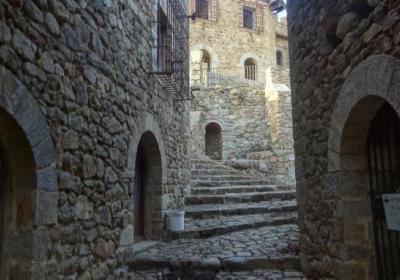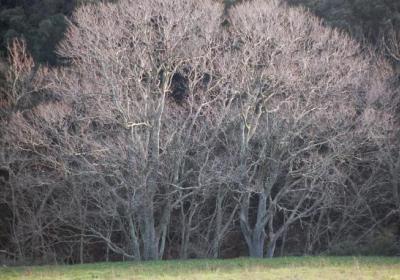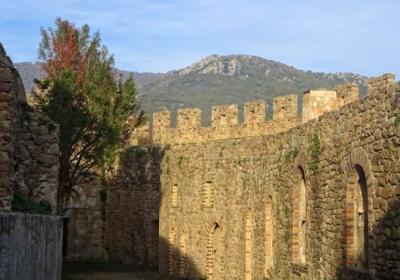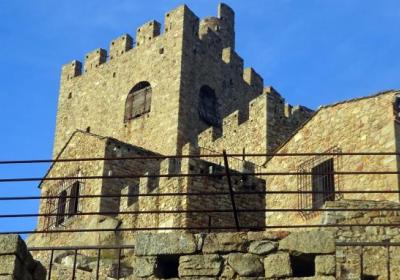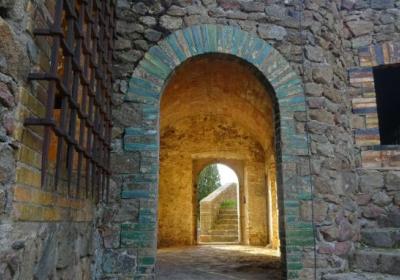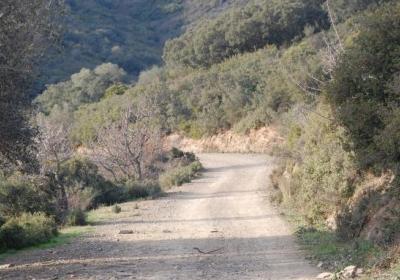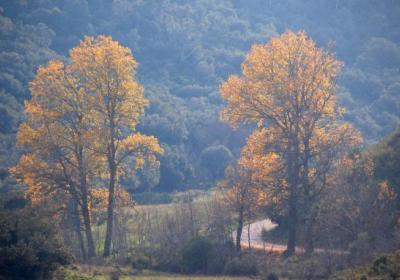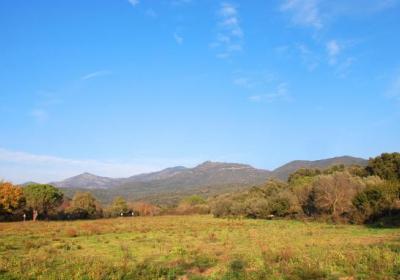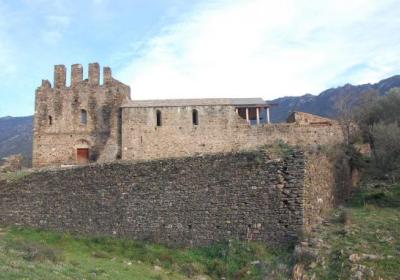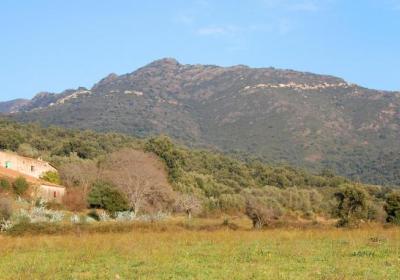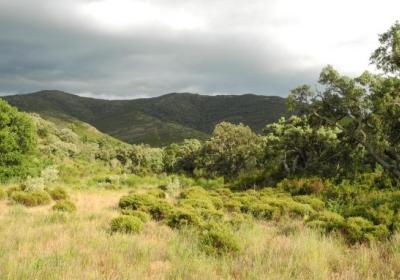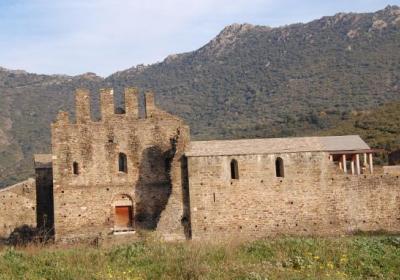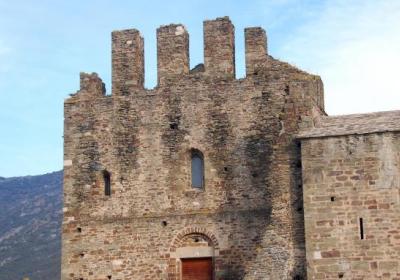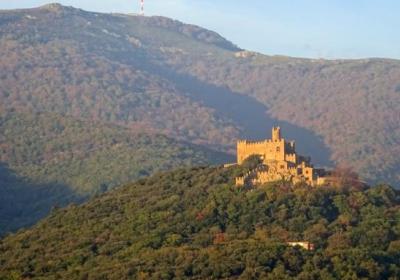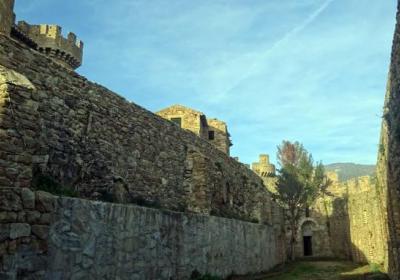The third phase of the Trans-Pyrenees Crossing begins among the fields of vineyards and olive trees in Vilamaniscle. From this beautiful village in the Empordà plains, the GR 11 moves deeper insider the fabulous Albera National Interest Nature Park. The Albera Mountains separates Empordà (S) and Roussillon (N) and has typical Mediterranean vegetation where the extensive forests of cork especially stand out. During this stage you will visit the beautiful Romanesque monastery of Sant Quirze de Colera and the spectacular Requesens Castle, which was rebuilt in the late 19th century following the pattern of neo-medieval times. During this stage the trails constantly change and alternate among paths, tracks and roads.
Considerable. Derived from the length and ascent to overcome. This stage does not have any technical difficulties.
No special equipment required.
Alt Empordà. 01:50.000. Editorial Alpina.
Topographic base of Catalonia 1:25.000. Geological and Cartographic Institute of Catalonia (ICGC).
Leave (1) Vilamaniscle (0:00 - 155m) from the Rabós road towards the NW. Pass through some vineyards. After about 2 km, leave the road to the left and take the paved path that goes to the right towards Sant Quirze de Colera (signposted). You will began to climb slowly along a valley that leads to (2) the Sant Quirze de Colera monastery (1:20 - 176m) and the Santa Maria de Colera Church. The Romanesque Benedictine monastery of Sant Quirze de Colera is composed of the Basilica of St. Quirze, the cloister, which in turn is the centre of the different monastery dependencies, a defence tower and a piece of wall, the Santa Maria Church and the remains of the old hospital. The architectural complex has been declared a National Cultural Heritage by the Generalitat de Catalunya.
Leave Sant Quirze de Colera and continue your journey through a dirt track that climbs to the NW towards (3) Plaja Hill (1:55 - 390m). You can see Mas Pils down below where you are headed now. Continue on the trail that descends to the secondary valley leaving the Migdia Peak (379m) to your right. Head down to (4) Mas Pils (2:20 - 245m), where you will find the road that connects the town of Espolla with France through the Banyuls Hill. Turn to the left and take the road towards Espolla. Continue along this road that winds down to the river valley of Orlina for about 5 km. You arrive at the (5) detour in Vilars (3:25 - 156m), a point where the GR 11 detours from Espolla and continues along a dirt trail that goes right and slightly ascends. First continue on a trail (towards the SW) and then a path (westwards) until reaching the (6) the centre of Vilars (3:50 - 220m).
From Vilars, the stage continues along the dirt trail that goes north and turns to the right. You will soon reach a trail detour where you will turn to the left. From that moment you will begin to climb the ridge of a mountain doing some zig-zags until you reach (7) Esparreguera Hill (4:35 - 388m). From this point you have a good view of the stage you will face next until Llosarda Hill, passing through the foothills of the Conillers Hills (586m) and the Roureda Hills (730m), almost reaching the Mig Peak (735m). From Esparreguera Hill continue along the flat trail that runs along the mountain (W). Pass by the Verna Fountain and began to ascend (NW). The sensational cork forest in Vinyes dominates this part of the stage. Leave the trail at the foot of the Roureda Hill and go up a path that runs along the Mig Peak and then reaches (8) Llosarda Hill (6:20 - 689m). The views from this point are magnificent: the Albera Mountains with the Puig Neulós Peak (1,257m) to the NW, the Canigó Massifs (2,786m), the Empordà plains, the Gulf of Roses, the mountains of Cap de Creus,...
Now you face the final stretch of the stage. From the hill descend towards the Mirapols Watercourse. After a stretch of steep descent you will reach the ruins of the Mirapols Farmhouse. Continue now on a trail that flanks the mountain. You reach a point where you can see the spectacular Requesens Castle. A few meters before Castell Hill, leave behind the Forn de Calç Refuge; this open shelter, property of the Empordanès Mountain Centre, is one of the options you have to spend the night in Requesens. Leave the castle on your left and walk about 2 km until reaching the small centre of (9) Requesens (8:30 - 500m), the end of the third stage.
Walking through the lonely Albera Mountains and discover its landscapes.
Visiting the Sant Quirze de Colera Monastery and the Santa Maria Church.
Exploring oak forests in the Alberes Mountains.
The picturesque Requesens Castle, which looks like a decoration from a film.
The Requesens Castle was completely rebuilt in the 19th century? Although the castle is originally from the 11th century and remained inhabited until the 16th century, it was thereafter abandoned and in the 19th century there were only some walls. The castle was rebuilt between 1893 and 1899 by the counts of Peralada, its owners, to turn it into a summer residence and following the criteria of Neomedieval buildings and the modernist influences of the time. The castle can be visited. (More information: www.castellderequesens.cat).
The numerous dolmens and menhirs that are found in the massif area of Alberes and Cap de Creus. Specifically, during this period you can visit: the Mas Roquer menhir (right beside the road before reaching Sant Quirze de Colera), the Morella dolmen (before reaching the Esparreguera Hill) and the Arreganyats dolmen (located near the source of the Verna).

